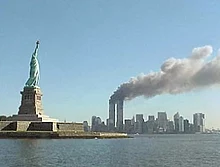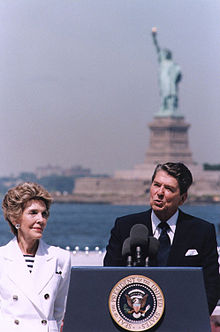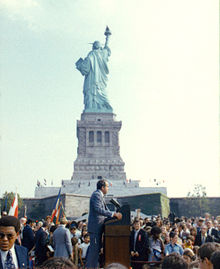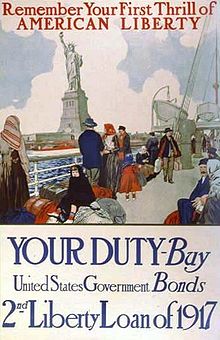Statue of Liberty
![]()
The title of this article is ambiguous. For other meanings, see Statue of Liberty (disambiguation).
The Statue of Liberty (English Statue of Liberty, officially Liberty Enlightening the World, also Lady Liberty; French La Liberté éclairant le monde) is a neoclassical colossal statue near New York, created by Frédéric-Auguste Bartholdi. Located on Liberty Island in New York Harbor, it was inaugurated on October 28, 1886, and is a gift to the United States from the people of France. The statue has been part of the Statue of Liberty National Monument since 1924 and classified as a UNESCO World Heritage Site since 1984.
The statue depicts the robed figure of Libertas, the Roman goddess of liberty. Standing on a massive pedestal, the copper-sheathed figure on a steel frame holds up a gilded torch with her right hand and holds a tabula ansata with the date of the American Declaration of Independence in her left hand. At her feet lies a broken chain. The statue is considered a symbol of freedom and is one of the most recognizable symbols of the United States. With a figure height of 46.05 meters and a total height of 92.99 meters, it is one of the tallest statues in the world, until 1959 it was the tallest.
Bartholdi was inspired by the French jurist and politician Édouard René de Laboulaye, who had declared in 1865 that any monument erected in honor of American independence would have to be a joint project of the peoples of France and the United States. Because of the tense political situation in France, work on the statue did not begin until the early 1870s. Laboulaye proposed in 1875 that the French finance the statue and the Americans the pedestal, as well as provide the building site. Bartholdi completed the head and the torch arm before the final appearance of the statue was decided. These parts were presented to the public at exhibitions. Funding initially proved difficult, particularly on the American side (for the pedestal), and work on the pedestal was threatened with abandonment in 1885 due to lack of funds. Joseph Pulitzer then organized a fundraising campaign with his newspaper, the New York World, to complete the project. The statue was eventually prefabricated in France, shipped to New York in pieces, and assembled on what was then called Bedloe's Island. President Grover Cleveland dedicated it on October 28, 1886, on Bartholdi Day.
The United States Lighthouse Board, the federal authority for lighthouses, was responsible for maintenance and administration until 1901. Subsequently, the War Department took over these responsibilities. Since 1933, the statue has been under the jurisdiction of the National Park Service. In 1938, it was closed to the public for the first time for renovations. By the early 1980s, the structure had deteriorated to the point where extensive restoration was necessary. From 1984 to 1986, the flare and much of the interior structure were replaced. After the attacks of September 11, 2001, and after Hurricane Sandy, the statue was closed temporarily on each occasion.

The statue on Liberty Island
Further development
Lighthouse Board and War Department (1886-1933)
When the torch was illuminated on the evening of the inauguration, it was barely visible from Manhattan. The New York World described the glow as "more like a glowworm than a beacon". Bartholdi suggested gilding the statue to increase the light reflection, but this proved too expensive. The United States Lighthouse Board, the federal agency responsible for lighthouses, took over the statue in 1887 and agreed to equip the flare for increased luminosity. Despite these efforts, the statue remained virtually invisible at night. When Bartholdi returned to the United States in 1893, he proposed further measures, all of which proved ineffective. He successfully lobbied for improved lighting inside the statue so that visitors could better perceive Eiffel's design. In 1901, President Theodore Roosevelt, once a member of the New York Committee, ordered the statue to be turned over to the War Department because it had not proven itself as a beacon. During the military administration of Bedloe's Island, an Army Signal Corps unit was stationed on the island until 1923, then military police.
The statue quickly became a landmark. Narratives from immigrants who entered through New York reported an uplifting feeling upon first seeing the statue. One immigrant from Greece recalled:
"I saw the Statue of Liberty. And I said to myself, 'Lady, you're such a beautiful! [You opened your arms and you get all the foreigners here. Give me a chance to prove that I am worth it, to do something, to be someone in America.' And always that statue was on my mind."
"I saw the Statue of Liberty. And I said to myself, 'Lady, you are such a beauty! You opened your arms and bring all the foreigners here. Give me a chance to prove that I'm worth doing something to be somebody in America.' And always that statue was in my thoughts."
- A Greek immigrant
Originally the statue had a matt copper colouring; shortly after 1900 a green patina spread due to oxidation. The first press reports about it appeared in 1902, and four years later it covered the entire statue. Convinced that the patina was a sign of corrosion, Congress appropriated $62,800 to thoroughly repaint the statue. Considerable public protest arose against the exterior painting. The Army Corps of Engineers (USACE) examined the patina to see if it had any harmful effects and concluded that it was more likely to protect the cladding, soften the contours, and make the statue more beautiful. As a result, the statue received only an interior coat of paint. The USACE also installed an elevator to transport visitors from the base to the top of the pedestal.
On July 30, 1916, during World War I, German saboteurs carried out an explosives attack on the Black Tom Peninsula in Jersey City, located not far from Bedloe's Island (now part of Liberty State Park). About 1000 tons of munitions, which were to be shipped to Britain and France, exploded and seven people died. The statue suffered minor damage, mostly to the flare arm, and was closed for ten days. The cost of repairs to the statue and buildings on the island was about $100,000. The narrow climb to the torch was closed for public safety reasons and remains so to this day.
That same year, Ralph Pulitzer, who had replaced his father as editor of the New York World, began a fundraising campaign. The goal was to raise $30,000 for a lighting system to illuminate the statue at night. Pulitzer claimed there were 80,000 donors, but the campaign fell short of its goal. A wealthy benefactor paid the difference in secret, which didn't come out until 1936. An underwater cable connected the island to the mainland power grid and floodlights were placed along the walls of Fort Wood. Gutzon Borglum, who later created Mount Rushmore, redesigned the torch, replacing much of the original copper with painted glass windows. On December 2, 1916, President Woodrow Wilson turned on the lights with a telegraph button. It bathed the statue in brilliant light. The electric lighting was installed in the torch, and henceforth the statue could be seen at night even from a greater distance than during the day. During the commissioning, Ruth Law flew past the statue in a "brilliantly illuminate[d]" plane with the word Liberty visible in brightly lit letters.
After the United States entered the war on April 6, 1917, the statue was frequently featured on recruiting posters and advertisements for Liberty Bonds (war bonds). It was intended to alert the public to the war's goal of securing freedom and to remind them that embattled France had given the Statue of Liberty to the United States. In 1924, President Calvin Coolidge used the authority granted by the Antiquities Act and declared Bedloe's Island with the Statue of Liberty a Statue of Liberty National Monument. The only successful suicide occurred five years later: a man climbed out of one of the windows in the crown and jumped into the depths.
National Park Service (1933-1982)
In 1933, President Franklin D. Roosevelt transferred responsibility for the statue to the National Park Service (NPS). As of 1937, the NPS was responsible for all of Bedloe's Island. After the Army left, the NPS began to convert the island into a park. The Works Progress Administration (WPA) tore down most of the old buildings, flattened the eastern end of the island, and replanted it. It also set granite steps for a new public entrance to the statue from the rear. The WPA also performed restoration work on the statue, temporarily removing the crown's beams to replace its rusted supports. Rusted cast iron steps in the base and upper stair section inside the statue were replaced with new reinforced concrete ones. Copper boarding was installed to prevent further damage from rainwater seeping through the base. The statue was closed to the public from May to December 1938.
During World War II, the statue remained open to visitors, but was not lit at night due to blackout. For a short time the lights were switched on on 31 December 1943 and on 6 June 1944 (D-Day), when the lights transmitted the signal "short-short-short-long", Morse code for V forVictory ("Sieg"). New, powerful lighting was installed in 1944-45, and from 8 May 1945 (VE-Day) the statue was again lit after sunset. The lights were on for only a few hours each evening; since 1957, the statue has been continuously illuminated each night. In 1946, the publicly accessible part inside the statue was covered with a special plastic film so that graffiti can be washed off.
In 1956, Congress decided to rename Bedloe's Island 'Liberty Island'; a proposal that Bartholdi had already made. The act also set the stage for funding an immigration museum on the island. Supporters considered this an approval of the project, but the government delayed releasing the funds. President Lyndon B. Johnson declared neighboring Ellis Island part of the Statue of Liberty National Monument in 1965. In 1972, the Immigration Museum finally opened in the base of the statue with a ceremony presided over by President Richard Nixon. Due to lack of funding, the museum had to close in 1991 after a new museum opened on Ellis Island.
In 1976, the NPS had a new lighting system installed to commemorate the United States Bicentennial. The statue was the focal point of Operation Sail, a regatta of tall ships from around the world that sailed into New York Harbor and around Liberty Island on July 4, 1976. The day of celebration ended with a large fireworks display near the statue.
Restoration and further development since 1982
In the course of planning for the statue's centenary in 1986, French and American engineers examined the structure in detail. In 1982, they concluded that the statue needed extensive restoration. The right arm had been improperly attached to the main body. It swayed more and more in strong winds, creating a significant risk of falling. In addition, the head had been mounted about 60 inches to the side of the center point and one of the beams drilled a hole in the right arm when the statue moved in the wind. The frame structure was badly corroded and about two percent of the panels of the outer shell had to be replaced. Although the problem with the frame structure had been identified in 1936 when some replacement cast iron beams had been installed, most of the corrosion was hidden by layers of paint that had been applied over the years.
In May 1982, President Ronald Reagan announced the formation of the Statue of Liberty-Ellis Island Centennial Commission, headed by Chrysler Chairman Lee Iacocca, to raise the needed funds. The commission succeeded in raising more than $350 million. This fundraising campaign was among the first in which corporations participated for marketing purposes (cause marketing).
In 1983, American Express
promoted itself by contributing one cent to the renovation for every transaction made with a credit card. This campaign alone raised $1.7 million.
In 1984, the statue was scaffolded and closed to the public due to renovation work. The layers of paint that had been applied to the inside of the copper cladding over decades were removed with liquid nitrogen donated by Union Carbide. Two layers of coal tar, which had been applied during the statue's construction to seal leaks and prevent corrosion, were removed by the sodablasting process without further damaging the copper. The soda ash required for this was provided by Church & Dwight. An asbestos-based substance that Bartholdi had used to prevent contact corrosion without success hampered the restorers' work. Workers inside the statue had to wear protective clothing with integrated respirators. Holes in the copper cladding were repaired and, where necessary, replaced with new copper. The replacement cladding came from the Bell Laboratories roof, which had a similar patina; in return, the laboratory received parts of the old cladding for testing purposes. It turned out that water had been leaking into the flare since the 1916 alterations, so it was replaced with a copy. Restorers considered replacing the arm and shoulder, but the National Park Service insisted on repairs.
The restoration also included the replacement of the entire anchoring. The puddled iron rods that Eiffel had used were removed step by step. The new bars attached to the pylon are made of low-carbon stainless steel, while the bars that now hold the brackets to the cladding are made of ferralium, an alloy that bends slightly when the statue moves and returns to its original position. To prevent the beam and arm from touching each other, the beam was realigned a few degrees. The lighting was also replaced once again; since then, halogen lamps cast beams of light on certain areas of the pedestal, thus highlighting them. A nondescript entrance built in the 1960s in the base was replaced by a wide portal with monumental bronze doors symbolically depicting the renovation. A modern elevator allows people with disabilities to access the viewing area of the pedestal. In addition, there was also an emergency elevator that reaches the height of the shoulder of the statue.
The statue's reopening and centennial celebration, July 3-6, 1986, was called Liberty Weekend. On July 4, a re-enactment of Operation Sail took place. The following day, Ronald Reagan rededicated the statue in the presence of French President François Mitterrand. The restoration project was awarded the Outstanding Civil Engineering Achievement Award by the American Society of Civil Engineers in 1987.
Immediately after the terrorist attacks on September 11, 2001, Liberty Island was closed to the public. The island was allowed back in late 2001, but the pedestal and statue remained off-limits. Access to the base was allowed again as of August 3, 2004, but the National Park Service announced visitors could not be allowed to enter the statue for security reasons. The agency justified this measure by saying that evacuation would be difficult in an emergency.
Ken Salazar, Secretary of the Interior in Barack Obama's administration, announced on May 17, 2009, that the statue would be reopened to the public on July 4, as a "special gift to America." Since then, the number of visitors allowed up to the crown per day had been limited. After the 125th anniversary on October 28, 2011, the statue was closed for a year to install a new staircase system inside to meet modern safety requirements and allow more people to visit at the same time in the future. Just one day after reopening on October 28, 2012, the statue had to be closed again due to the effects of Hurricane Sandy. The statue itself was not damaged, but parts of the infrastructure in the base were destroyed. The renovation lasted until the following summer; the Statue of Liberty reopened on National Day, July 4, 2013.

September 11, 2001: The Statue of Liberty with the burning towers of the World Trade Center in the background

The new staircase for access to the crown

July 4, 1986: Nancy and Ronald Reagan on the occasion of the reopening

September 26, 1972: President Richard Nixon gives a speech at the opening of the Immigration Museum.

Government poster advertising the purchase of war bonds with the Statue of Liberty (1917).

Bedloe's Island in 1927 with statue and army buildings
Visit
Admission to the Statue of Liberty National Monument is free. However, all visitors must pay to use the ferries, as private ships and boats are not allowed to dock at the island. Since 2007, the company State Cruises holds the concession for transportation and ticket sales. It replaced Circle Line, which had previously operated the ferry service since 1953. The ferries, which depart from Liberty State Park in Jersey City and Battery Park in Lower Manhattan, each also run through Ellis Island, making a round trip possible. Visitors who want to enter the pedestal must be in possession of an additional, free admission ticket.

Liberty Island is lined with tourists during the day (2012)
Questions and Answers
Q: What is the official name of the Statue of Liberty?
A: The official name of the Statue of Liberty is Liberty Enlightening the World.
Q: Where is the Statue of Liberty located?
A: The Statue of Liberty is located on Liberty Island, near New York City Harbor.
Q: What does it commemorate?
A: The Statue of Liberty commemorates the signing of the United States Declaration of Independence.
Q: Who gave it to the United States?
A: The people of France gave it to the United States in 1886.
Q: What does it represent?
A: It represents a woman wearing a stola, a crown and sandals, trampling a broken chain, and with a torch in her raised right hand and a tabula ansata, or tablet where the date of the Declaration of Independence JULY IV MDCCLXXVI (1776) is written, in her left hand.
Q: What does it welcome?
A: The Statue of Liberty welcomes visitors, immigrants, and returning Americans travelling by ship.
Q: Who was its inspiration based on?
A: The Statue of Liberty was based on Libertas (also known as Eleutheria), who was also known as Goddess Of Liberty and had been given a temple on Aventine Hill in c. 238 BC.
Search within the encyclopedia